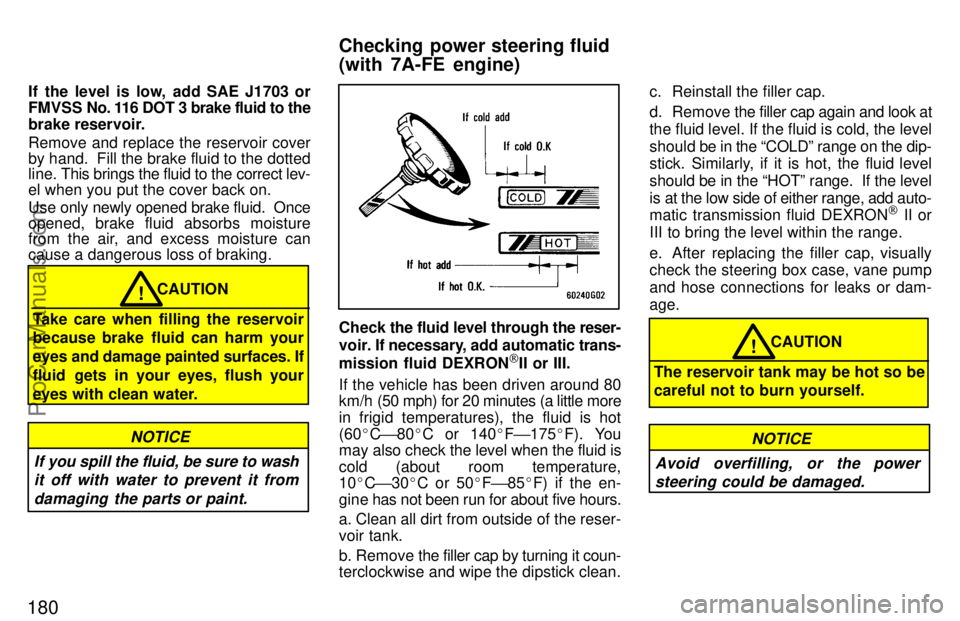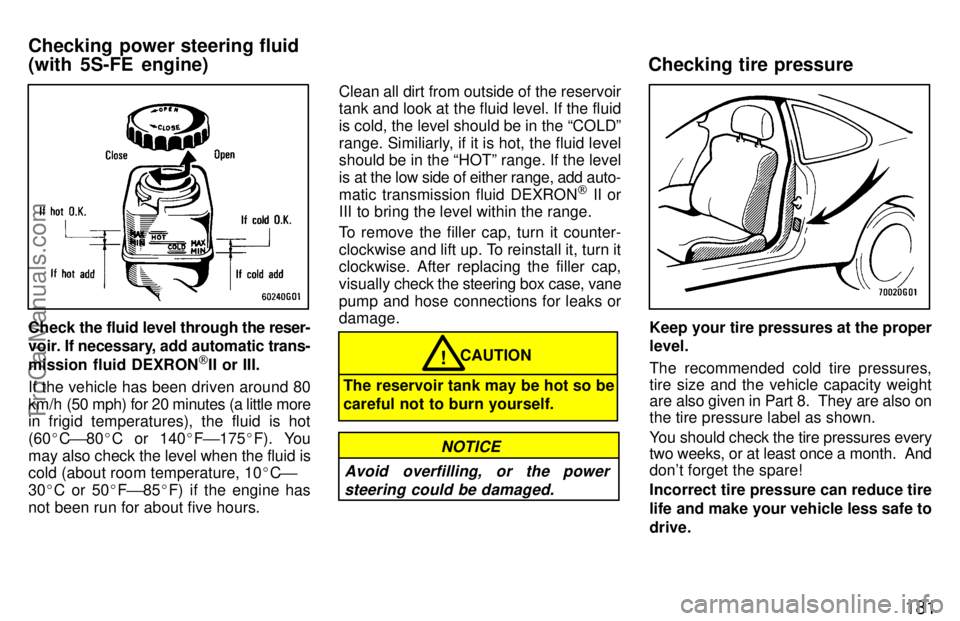Page 186 of 218

180
If the level is low, add SAE J1703 or
FMVSS No. 116 DOT 3 brake fluid to the
brake reservoir.
Remove and replace the reservoir cover
by hand. Fill the brake fluid to the dotted
line. This brings the fluid to the correct lev-
el when you put the cover back on.
Use only newly opened brake fluid. Once
opened, brake fluid absorbs moisture
from the air, and excess moisture can
cause a dangerous loss of braking.
CAUTION
Take care when filling the reservoir
because brake fluid can harm your
eyes and damage painted surfaces. If
fluid gets in your eyes, flush your
eyes with clean water.!
If you spill the fluid, be sure to wash it off with water to prevent it from
damaging the parts or paint.
NOTICE
Check the fluid level through the reser-
voir. If necessary, add automatic trans-
mission fluid DEXRON
[II or III.
If the vehicle has been driven around 80
km/h (50 mph) for 20 minutes (a little more
in frigid temperatures), the fluid is hot
(60 �C ' 80 �C or 140 �F ' 175 �F). You
may also check the level when the fluid is
cold (about room temperature,
10 �C ' 30 �C or 50 �F ' 85 �F) if the en-
gine has not been run for about five hours.
a. Clean all dirt from outside of the reser-
voir tank.
b. Remove the filler cap by turning it coun-
terclockwise and wipe the dipstick clean. c. Reinstall the filler cap.
d. Remove the filler cap again and look at
the fluid level. If the fluid is cold, the level
should be in the COLDº range on the dip-
stick. Similarly, if it is hot, the fluid level
should be in the HOTº range. If the level
is at the low side of either range, add auto-
matic transmission fluid DEXRON
[ II or
III to bring the level within the range.
e. After replacing the filler cap, visually
check the steering box case, vane pump
and hose connections for leaks or dam-
age.
CAUTION
The reservoir tank may be hot so be
careful not to burn yourself.!
Avoid overfilling, or the power steering could be damaged.
NOTICE
Checking power steering fluid
(with 7A-FE engine)
ProCarManuals.com
Page 187 of 218

181
Check the fluid level through the reser-
voir. If necessary, add automatic trans-
mission fluid DEXRON
[II or III.
If the vehicle has been driven around 80
km/h (50 mph) for 20 minutes (a little more
in frigid temperatures), the fluid is hot
(60 �C ' 80 �C or 140 �F ' 175 �F). You
may also check the level when the fluid is
cold (about room temperature, 10 �C '
30 �C or 50 �F ' 85 �F) if the engine has
not been run for about five hours. Clean all dirt from outside of the reservoir
tank and look at the fluid level. If the fluid
is cold, the level should be in the COLDº
range. Similiarly, if it is hot, the fluid level
should be in the HOTº range. If the level
is at the low side of either range, add auto-
matic transmission fluid DEXRON
[ II or
III to bring the level within the range.
To remove the filler cap, turn it counter-
clockwise and lift up. To reinstall it, turn it
clockwise. After replacing the filler cap,
visually check the steering box case, vane
pump and hose connections for leaks or
damage.
CAUTION
The reservoir tank may be hot so be
careful not to burn yourself.!
Avoid overfilling, or the power steering could be damaged.
NOTICE
Keep your tire pressures at the proper
level.
The recommended cold tire pressures,
tire size and the vehicle capacity weight
are also given in Part 8. They are also on
the tire pressure label as shown.
You should check the tire pressures every
two weeks, or at least once a month. And
don't forget the spare!
Incorrect tire pressure can reduce tire
life and make your vehicle less safe to
drive.
Checking power steering fluid
(with 5S-FE engine) Checking tire pressure
ProCarManuals.com
Page 191 of 218

185
If wheel covers are used, they will be
scratched by the chain band, so remove
the covers before putting on the chains.
�Do not exceed 50 km/h (30 mph) or
the chain manufacturer's recom-
mended speed limit, whichever is
lower.
� Drive carefully avoiding bumps,
holes, and sharp turns, which may
cause the vehicle to bounce.
� Avoid sharp turns or locked-wheel
braking, as use of chains may ad-
versely affect vehicle handling.
CAUTION!
Do not attempt to use a tire chain on
the compact spare tire, as it may
result in damage to the vehicle aswell as the tire.
NOTICE
WHEN TO REPLACE YOUR WHEELS
If you have wheel damage such as
bending, cracks or heavy corrosion,
the wheel should be replaced.
If you fail to replace damaged wheels, the
tire may slip off the wheel or they may
cause loss of handling control.
WHEEL SELECTION
When replacing wheels, care should
be taken to ensure that the wheels are
replaced by ones with the same load
capacity, diameter, rim width, and off-
set.
This m ust be observed on compact spare
tires, too.
Correct replacement wheels are available
at your Toyota dealer.
A wheel of a different size or type may ad-
versely affect handling, wheel and bear-
ing life, brake cooling, speedometer/
odometer calibration, stopping ability,
headlight aim, bumper height, vehicle
ground clearance, and tire or snow chain
clearance to the body and chassis. Replacement
with used wheels is not rec-
ommended as they may have been sub-
jected to rough treatment or high mileage
and could fail without warning. Also, bent
wheels which have been straightened
may have structural damage and there-
fore should not be used. Never use an in-
ner tube in a leaking wheel which is de-
signed for a tubeless tire.
Replacing wheels
ProCarManuals.com
Page 200 of 218
194
Light bulbsBulb
No.WType
Rear side marker, stop
and tail lights (coupe)115727/8C
Rear side marker lights
(liftback)1944.9D
Rear turn signal lights115627C
Stop and tail lights115727/8C
Back-up lights115627C
License plate lights1685D
High mounted stoplight92118C
Interior lights
(without moon roof)Ð10C
Interior lights
(without moon roof)Ð8C
Personal lightsÐ5E
Glovebox lightÐ1.2D
Door courtesy lightsÐ3.8D
Luggage compartment
lightÐ5E
Trunk lightÐ3.8D
A: HB4 halogen bulbs
B: HB3 halogen bulbs
C: Single end bulbs
D: Wedge base bulbs
E: Double end bulbs
1. Unplug the connector while de-
pressing the lock release.
If the connector is tight, wiggle it.2. Turn the bulb and remove it.
ÐHeadlights
ProCarManuals.com
Page 201 of 218
195
3. Install a new bulb and the connec-
tor into the mounting hole.
Aiming is not necessary after replacing
the bulb. When aiming adjustment is nec-
essary, contact your Toyota dealer.1. Loosen the retainer screw and take
out the beam unit.2. Turn the cover counterclockwise
and remove it.
ÐFront fog lights
ProCarManuals.com
Page 202 of 218
196
3. Disconnect the cords.4. Release the bulb retaining spring
and remove the bulb. Install a new
bulb and the bulb retaining spring.
To install the bulb, align the cutouts of the
bulb with the protrusions of the mounting
hole.5. Connect the cords, install the cover
and turn it clockwise so that two
triangle marks are aligned. Plug the
connector together. Install the beam
unit and tighten the screw.
ProCarManuals.com
Page 215 of 218
209
Fuses (type A)
1 AM2 30 A: Starting system
2 HAZARD 10A: Emergency flashers
3 HORN 7.5 A: Horns
4 Radio NO.120 A: Car audio system
5 ECU-B 15 A: Anti-lock brake sys-
tem, cruise control system
6 DOME 10 A: Interior lights, personal
lights, luggage compartment light, trunk
light, door courtesy lights, clock
7 HEAD (LH) 15 A: Left-hand head-
light
8 HEAD (RH) 15 A: Right-hand head-
light9 SPARE: Spare fuse
10 SPARE: Spare fuse
11 SPARE: Spare fuse
12 ALT-S 7.5 A: Charging system
13 SRS WRN 7.5 A: SRS airbag warn-
ing light
14 EFI 15 A: Multiport fuel injection sys-
tem/sequential multiport fuel injection
system
15 HEAD (LH) LO 15 A: Left-hand
headlight (low beam)
16 HEAD (RH) LO 15 A: Right-hand
headlight (low beam)
17 HEAD-HI (RH) 15 A: Right-hand
headlight (high beam)
ProCarManuals.com
Page 216 of 218

210
18 HEAD-HI (LH) 15 A: Left-hand
headlight (high beam)
19 DRL 7.5 A: Daytime running light
system
20 ECU-IG 15 A: Electronically con-
trolled automatic transmission system,
anti-lock brake system
21 SEAT-HTR 20 A: No circuit
22 PANEL 7.5 A: Instrument panel
lights
23 STOP 15 A: Stop lights, high
mounted stoplight, multiport fuel injection
system/sequential multiport fuel injection
system, cruise control system cancel de-
vice, electronically controlled automatic transmission system, anti-lock brake
system
24 FOG 20 A: Front fog lights
25 CIG & RAD 15 A:
Cigarette lighter,
digital clock display, car audio system
26 IGN 7.5 A: Charging system, dis-
charge warning light, multiport fuel injec-
tion system/sequential multiport fuel in-
jection system, SRS airbag system
27 WIPER 20 A: Windshield wipers and
washer, rear window wiper and washer
28 MIR-HTR 10 A: Multiport fuel injec-
tion system/sequential multiport fuel in-
jection system
29 TURN 10 A: Turn signal lights, emer-
gency flashers
30 TAIL 15 A: Tail lights, parking lights,
front side marker lights, rear side marker
lights, license plate lights
31 HTR 10 A: Air conditioning system,
rear window defogger
32 GAUGE 10 A: Gauges and meters,
power door lock system
33 ST 7.5 A: Starting system, multiport
fuel injection system/sequential multiport
fuel injection system
34 A/C 10 A: Air conditioning system
35 OBD II 7.5A: On-board diagnosis
system Fuses (type B)
36 RDI 30 A: Electric cooling fan
37 CDS 30 A: Electric cooling fan
38 AM1 40 A:
Electronic ignition sys-
tem/distributor ignition system
39 DOOR 30 A: Power door lock sys-
tem, convertible top control system
40 DEF 30 A: Rear window defogger
41 POWER 30 A: Power windows, elec-
tric moon roof
Fuses (type C)
42 HTR 40 A: Air conditioning system
43 ALT 100 A: ALT-Sº, TAILº,
DOORº, DEFº and POWERº fuses
44 MAIN 60 A: Starting system, head-
lights, AM2º, HAZARDº, HORNº,
DOMEº and RADIOº fuses
45 ABS 50 A: Anti-lock brake system
ProCarManuals.com